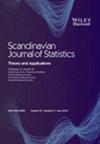Remove unwanted variation retrieves unknown experimental designs
IF 1
4区 数学
Q3 STATISTICS & PROBABILITY
引用次数: 0
Abstract
Remove unwanted variation (RUV) is an estimation and normalization system in which the underlying correlation structure of a multivariate dataset is estimated from negative control measurements, typically gene expression values, which are assumed to stay constant across experimental conditions. In this paper we derive the weight matrix which is estimated and incorporated into the generalized least squares estimates of RUV‐inverse, and show that this weight matrix estimates the average covariance matrix across negative control measurements. RUV‐inverse can thus be viewed as an estimation method adjusting for an unknown experimental design. We show that for a balanced incomplete block design (BIBD), RUV‐inverse recovers intra‐ and interblock estimates of the relevant parameters and combines them as a weighted sum just like the best linear unbiased estimator (BLUE), except that the weights are globally estimated from the negative control measurements instead of being individually optimized to each measurement as in the classical, single measurement BIBD BLUE.去除不需要的变异,检索未知的实验设计
去除不想要的变异(RUV)是一种估计和归一化系统,其中多变量数据集的潜在相关性结构是根据阴性对照测量来估计的,通常是基因表达值,假设这些值在实验条件下保持不变。在本文中,我们推导了权重矩阵,该矩阵被估计并合并到RUV逆的广义最小二乘估计中,并表明该权重矩阵估计了负控制测量的平均协方差矩阵。因此,RUV逆可以被视为一种针对未知实验设计进行调整的估计方法。我们证明,对于平衡不完全块设计(BIBD),RUV逆恢复相关参数的块内和块间估计,并将它们组合为加权和,就像最佳线性无偏估计量(BLUE)一样,只是权重是从负控制测量中全局估计的,而不是像经典中那样对每个测量单独优化,单次测量BIBD蓝色。
本文章由计算机程序翻译,如有差异,请以英文原文为准。
求助全文
约1分钟内获得全文
求助全文
来源期刊

Scandinavian Journal of Statistics
数学-统计学与概率论
CiteScore
1.80
自引率
0.00%
发文量
61
审稿时长
6-12 weeks
期刊介绍:
The Scandinavian Journal of Statistics is internationally recognised as one of the leading statistical journals in the world. It was founded in 1974 by four Scandinavian statistical societies. Today more than eighty per cent of the manuscripts are submitted from outside Scandinavia.
It is an international journal devoted to reporting significant and innovative original contributions to statistical methodology, both theory and applications.
The journal specializes in statistical modelling showing particular appreciation of the underlying substantive research problems.
The emergence of specialized methods for analysing longitudinal and spatial data is just one example of an area of important methodological development in which the Scandinavian Journal of Statistics has a particular niche.
 求助内容:
求助内容: 应助结果提醒方式:
应助结果提醒方式:


